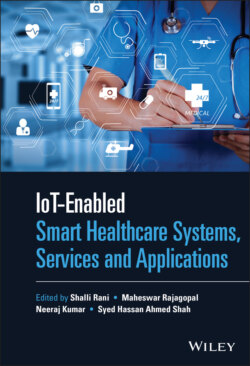Читать книгу IoT-enabled Smart Healthcare Systems, Services and Applications - Группа авторов - Страница 20
1.2.5 Fifth Generation (5G) in Smart Healthcare
ОглавлениеThe emerging technologies discussed before having contributed a great part in smart medication, telemedicine, and to provide remote assistance to the patients. Another smart technology named 5G is currently one of the fastest growing industries. 5G is proposed by researchers and experts to continue to assist and monitor patients in several diseases. Smartly designed gadgets and sensors collect information from a number of resources and provide guidance to anyone from anywhere to assist them in taking the right medication in the right manner so that the mistakes can be prevented to use medicines as well as to reduce the cost of treatments and medicines [21].
5G is the upcoming generation of today’s 4G network, so 5G can deliver the speedy, extensible network having the larger volume. Instead of providing the fastest Internet connection, the healthcare industry is also getting benefit due to 5G's reliable connectivity for heavy medical devices with increased spectrum, greater capacity, more users as compared to previous LTE networks. 5G can technically provide a low latency of 1 ms, as compared to the previous 20 ms latency. It is good enough to strengthen medical sensors and devices, medical equipment, and video streaming, which may be helpful in telemedicine, teleconsultation, and remote surgery with clean streaming and detailed information deliverance. 5G has also overcome the data transfer issues faced in high‐latency networks with stable high speed. 5G provides a greater number of facilities as compared to 4G in smart diabetes detection. It can provide the following five benefits to the patients as well as paramedical staff.
Profitability: It makes users aware of a pre‐diabetic condition if there is one and provides them with a healthy way of life, which can save their expenditures on treatment and medicines For older people who are long‐term patients and unable to attend doctors, it provides tele‐treatment.
Convenience: 5G does not discomfort the patient as it supports smart‐clothing glucose monitoring. Another instance is that healthcare providers are extending their duties outside the hospital through real‐time video conferencing.
Personification: 5G uses several machine learning algorithms and different computing techniques for the prevention of diabetes. Depending on patients’ health records, 5G generates a personalized treatment for e patient.
Durability: 5G supports efficient sharing of useful information between doctors and patients and friends and family to change the mental condition of patients so that they can feel self‐motivated and produce good changes in their environment and be prepared for a better future treatment.
Elegance: With its intellectual characteristics toward patient health and resources, it can detect diabetes sooner and prevent its causes.
